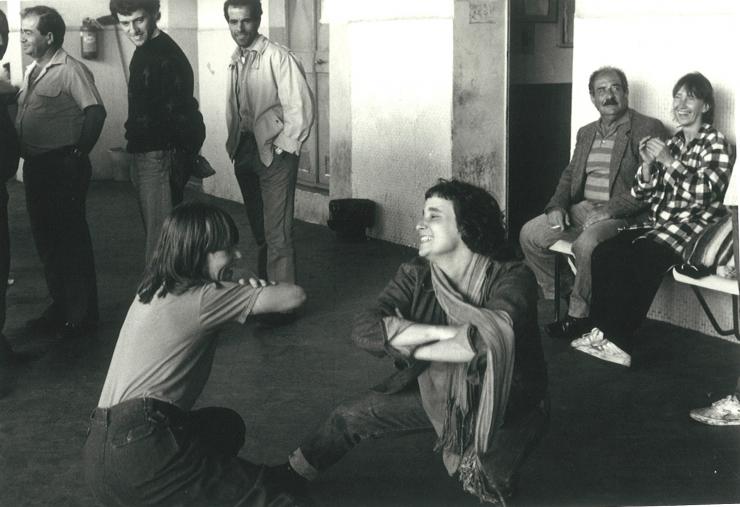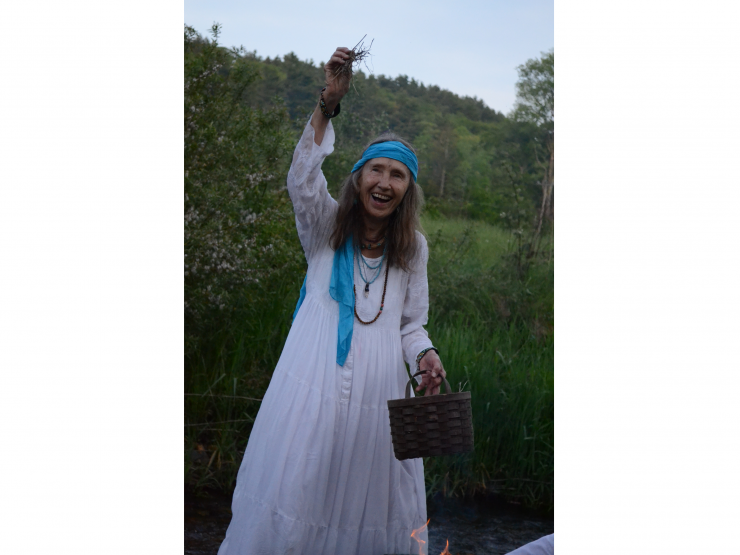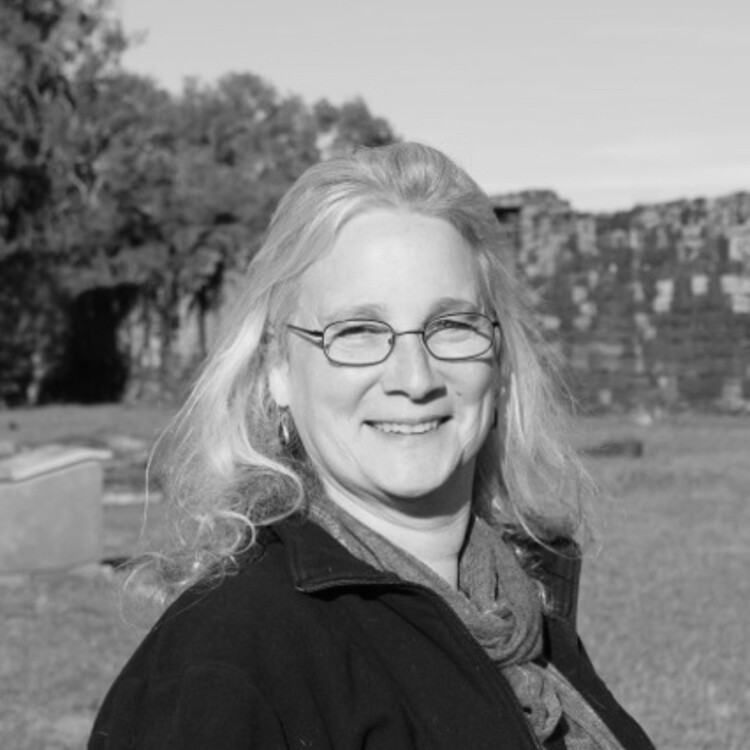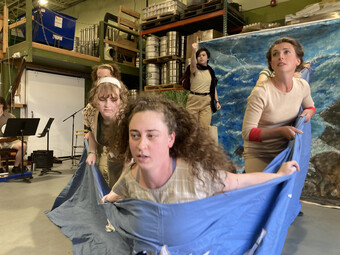A Conversation between Stacy Klein of Double Edge Theatre and Jennifer Johnson of The Charlestown Working Theater
I met Double Edge Theatre's Founding Artistic Director Stacy Klein in 1993, just as my colleagues and I were beginning our work at The Charlestown Working Theater. I had been transformed and inspired by seeing DE’s Song of Absence performed in the company’s space in Allston, Massachusetts, and I soon began a lifelong process of training and working with the company. Double Edge describes its thirty-two-year training methodology as the cornerstone of its creative process, focusing on the discovery of the body and voice as an integral and responsive expressive vessel, driving individual exploration, ensemble collaboration, and performance creation. I was interested in talking to Stacy about her early theatrical training and experiences in Poland, and her relationship with Rena Mirecka, lead actress of the famed Teatr Laboratorium, and Stacy’s friend and mentor.
Jennifer Johnson: Back in the mid-seventies, what was your initial impulse to go to Poland for training, what were you looking for in particular?
Stacy Klein: I didn’t know I was looking for training. I didn’t know what training was. I knew that I didn’t like the training I was getting, the theatre training. It was in some sense boring because it was all about what I was thinking, and what was the subtext of what I was thinking, but that didn’t involve me. I felt like I was a lot larger than what I was talking about, or the meaning of the words. So I was looking for a different kind of theatre than I was seeing or being trained for. That was in 1975.
Jennifer: Where were you with your theatrical education at that time?
Stacy: I was at Boston University. I was a directing major. The first two years you took theatre acting classes, and one of the acting classes I took was with Maxine Klein. That work was much more physical, engaging with play, which made sense to me. Then I had good teachers, Jim Spruill and Bill Young, and they were very interested in different forms, but the training was very typical; movement wasn’t really movement. We did meditation in movement class, and it was more related maybe to dance. The vocal classes were very normal classes, and the theatre was what I call the “talking theatre,” where it was all word-based. So when my co-directing student Jim Simpson saw the poster to go to Poland for the summer, and he knew about Grotowski’s theatre, he was like this looks cool, and so I went.
In the training itself, I had never been that exhilarated in my life, certainly not in theatre. It was brutal training, we were running and jumping and doing the horse gallop for what seemed to be ten hours. Endless. It was for me the first time I had felt the experience of my whole being, which is what I think I was seeking in theatre from the time I was seven.
Jennifer: Where did you go, and what was it like?
Stacy: We went all over Poland and we actually saw something like forty performances in six weeks. The theatre was really, really alive there. For instance, the repertory theatres were very physical and image-based, not totally word-based. Although the word and the interpretation were important, it was much more physical, probably more like theatre would be today in the repertory theatre, as compared to 1975. Then it was more like you stood there and said your lines, and the blocking would be related to the words only, not to different kinds of physicalities or impulses. I remember seeing One Flew Over the Cuckoo’s Nest with the actor [Wojtek] Pszoniak, and it was amazing. It was all in Polish of course, but it didn’t matter, you understood because of the whole presence of the actor. Then I saw the work of director Kazimierz Braun, who later moved to the United States and became a teacher. He did two performances. One was Anna Livia, based on the Joyce novel, and the sets were related to the actors, they weren’t sets that were representative. For instance, in that performance, two actors were in a bed that was over the stage, flying—it was—wow. I saw [Józef] Szajna’s Dante, and that involved a huge, gigantic ball, and an actor was inside of the ball, and I think there were actors on top of the ball rolling across the stage, so it really appealed to my sense of objects and physicality. The physicality was within the objects.
Jennifer: So that’s when you started working with Rena Mirecka?
Stacy: Actually, yes.

Jennifer: You came back to the United States knowing what you were interested in pursuing. Then the next summer you went back to Poland again to train.
Stacy: It was amazing, I already knew that I wanted to do that training, and after the first day I broke my collarbone and was in the hospital. So I didn’t really have the opportunity to work with them for more than that one day.
I tried to train with them when they came to NYU the following January, but Rena said that I was not ready, that I was having fear in my body. I had had major surgery. I had actually had three surgeries. I was on a cane for several months. She was right, I wasn’t ready. I was scared. When she saw me she wrote in my notebook, you have tried and tried and tried and therefore succeeded.
Jennifer: During that session what were you experiencing in training and by that I don’t mean your impressions of it, but what was remarkable to you and compelling enough for you to have this essentially lifelong relationship with Rena.
Stacy: We were very close. She went to the hospital with me and we really connected there. She couldn’t speak English then so she was speaking to me in French, and it was like a little world in and of itself. I think that she understood something about me in that survival situation. I also couldn’t speak to anybody at the hospital and it was a whole reality that way.
Jennifer: It sounds like the personal relationship first informed the training relationship.
Stacy: Yes, I think there is something about her that was compelled by that experience. As lofty as the training could be, she is always very tied to something real—survival.
In the training itself, the day that I was training, I think I had never been that exhilarated in my life, certainly not in theatre. It was brutal training, we were running and jumping and doing the horse gallop for what seemed to be ten hours, although it might have only been two hours! Endless. You never had a chance to think about “is my hair okay?” or “what does this word mean?” It was for me the first time I had felt the experience of my whole being, which is what I think I was seeking in theatre from the time I was seven, what I had glimmers of as a kid when I was playing, pretending to be a princess or whatever, totally believing, totally engaged. As I grew up and tried to do that in theatre it wasn’t like that, so I was less and less engaged. In fact I thought there must be something wrong with me, I probably can’t do theatre, because I can’t force myself to engage. I was convincing myself that I couldn’t be totally involved. I was thinking of a parallel, like sex is something that’s total and that’s what I wanted in my whole life, that feeling that I’m totally engaged with my spirit, with my emotions, with my body. It was amazing and terribly difficult. When I broke my collarbone I was doing a tiger leap. That was an important moment for me because what is trying, and what is trying? These are two different things. Trying involves reaching your potential, it’s not a suicidal thing, it’s not a daredevil thing; it’s really about going beyond where you are, it’s about you, and about your trying.
Jennifer: It speaks to the truly transformational element of training, which is about feeling powerful as yourself, which if it becomes a practice, becomes about how you live your life.
Stacy: Not just feeling powerful, but being powerful.
Jennifer: So, you began to work on incorporating training as part of your directing work. How did the actors or the students that you were working with respond to that?
Stacy: That was the beginning of something. I was asked to teach training in beginning acting, so I had a class every semester and I taught training, and that gave me the opportunity to find out how scene work related to training. So the students would have to create scenes, and it was very interesting as they were beginning acting with a combination of non-actors and actors. They couldn’t not be engaged when they were running around, that was clear to me. When the students got up to make scenes, those who were really interested could actually make up some really great scenes and material because of the energy that they got in training. Then in November 1981, I did a performance called RITES, a modernization of The Bacchae set in a women’s bathroom in England. What was interesting to me was studying the Greeks—I love Euripides and the duality of Euripides—and the Greek choruses as women celebrating Dionysus and the whole idea of the desire of women—all these different things were merging. We did training, which was training and plastiques, basically. It was a great thing, because the training could go right into the performance. There was that wildness, and we could reach that wildness with training so it worked really well. And that’s how Double Edge started. We were working with training, and during rehearsal we would train and improvise the script, often times with the training, so that people could actually push themselves with the script. All the first plays were very physical, or had physical scenes in them. The first plays we called The Women’s Cycle. That ended with an adaptation of Christina Bruckner’s If You Had Spoken, Desdemona which we called Had She Spoken, and that was the first time we devised something. But our training was limited to three-week periods when we would get a space, and training and rehearsal, then presenting. So we’re talking about six total weeks twice a year right in the beginning. At some point it was like we have to have a space, and we got our space right before we made Had She Spoken.
Jennifer: Securing your space, a church hall in Allston, gave you the capacity to work in a new way.
Stacy: Right, we didn’t just have to work from seven to eleven in a rented space. We worked from 9 am until 1 o’clock in the morning and so that space gave us Double Edge and Double Edge’s training. Before that all we could do is kind of run around and do some minimal plastiques, and maybe a little bit of corporal work that I had learned from Rena. When we got our space, we could play, and not only play, but play with things, like objects, like spools, or cement blocks, or balancing or things that were very enticing for me, and that I saw as part of training. That was the big thing that changed the training into my own training.
But also there was development. Not just to have that stuff but to be able to develop something. In my mind the research really began with the space, the real research. You can’t really develop something in four hours a day when you have to make a performance in a three-week time period. In that case you have to use the object only as a way to make the performance, you can’t use it as a way to research. And that year we could also bring Rena. She came back in 1985 as soon as we got the space.
Jennifer: Now that you were not just Rena’s student, but a director developing a company, how was it different working together?
Stacy: Rena lived with us and worked with us for three weeks. She saw an awful performance that we did—Bold Stroke for Wife—it wasn’t a terrible performance, but an unrealized idea, but I think it helped her see what our dilemmas were. She did a workshop focused on partner work and yoga, which was really great and that began my practice of partner work, which is still paramount to me.

Jennifer: Can you talk about what partner work is?
Stacy: It is very similar to work with objects. It is work with the other. I find it very hard to have the other by myself, particularly in theatre. It’s a little different when you’re writing, but in theatre you want to be engaged. So partner work is your audience or your mirror. Maybe it starts with certain exercises, but develops into a whole relationship. My training and my teaching are all based on partner work, and the relationship between partner work and object work. It’s a place where I think the human being is very engaged. You have the resistance of your partner; you can’t make your partner do what you want—you have to invite your partner to do what you want, and you have to convince them to do what you want, and they have to convince you, so there’s a sense of real engagement and play. And then it’s developed to have a sense of risk, not a dangerous risk, but surprise and risk, so maybe you jump on someone’s back, or you walk on someone’s back, or you throw someone. I find partner work to be very exhilarating, and also moving.
Jennifer: I’m jumping now to the more recent work at the Farm [the 100-acre property in Ashfield that has been home to Double Edge since 1994]. Something that was very striking to me when I trained with Rena was the thoughtful, extremely precise planning for a session, so when you walked into the room there was a feeling of inevitability, even at the same time that anything could happen.
Stacy: That is a very good description. I think Rena is the most disciplined person I’ve ever encountered, which allows her to really plan everything. She has a whole score for an evening. She has a score for each person, which has nothing to do with what the training might be, but the story of the training is very clear, and also in some ways for Rena it doesn’t ever change. She’s still working on the same characters, or figures, or archetypes that she’s always been working on. In a way it’s a testament to her amazing imagination that she never repeats anything, although the training is the same, a lot of her actions are the same, her materials are the same, except for at Double Edge where she could have the whole company behind her and make whatever she wanted.
Jennifer: That’s important to note. I think it’s easy to think of training as preparation for something; you’re preparing yourself in your training, and there is that part of it obviously, however, the training itself as the thing, the creative act rather than preparation for the creative act, is earth shattering, because it is so freeing, so focused on being present, that it develops a kind of demand for presence that is rare in a theatrical experience.
Stacy: Yes! I think depending on the people who are involved or the location, the training is very different, even though nothing basically needs to change. I think that is a key. I remember once we did this great work with Rena, she was blown away, really happy. We were in Poland. And the next day she said, “Do it again.” We couldn’t even begin. We had no idea. So we tried to do the things that we were doing, and it totally didn’t work.
Jennifer: And that’s what the discipline really is, the redefinition of repetition.
Stacy: Yes, and what’s your take-away from the great improvisation, what are you remembering? For instance, I remember I had my brown skirt on, and I’m holding it, maybe like a baby, or maybe like chains or something like that, and all I wanted to do was repeat that action. But I am not repeating anything, because you can never repeat an action, you have to repeat the underneath, the essence. That was the problem that Double Edge was encountering at that time. A big question about training, how is it related to yourself? If you’re transporting the action, how do you transport yourself within that action without having the whole score?
Our idea is that we want people to find their own training. Training exists to help you find your uniqueness and your voice, and so we expect and want that people will leave here with some means to develop their own voices.
Jennifer: There is a foundational, elemental aspect of Double Edge training. What can you say about the training of the company today, and the training of students, both at the Farm and away?
Stacy: We really believe in training as something that is essential to theatre.
It’s a very collaborative process. Matthew’s [Glassman, Double Edge Co-Artistic Director] training definitely hails from my original training, as does Carlos’s [Uriona, Double Edge Co-Artistic Director], but Matthew’s training is unique to Matthew and Carlos’s training is unique to Carlos, and we have a dialogue about that. I had a really good time with them with Anne [Bogart] and SITI Company because we were really working together in the room making this improvisation. Thirty-three years later with the ensemble I think we are finding a new training, a new way of working.

Jennifer: I would like you to say something about the vast number of students that Double Edge has. The training model is not just about developing the company, the model is really about reaching out, for example with the open training.
Stacy: We do the open trainings at the Farm and we also do them on tour. We host open trainings of different kinds, such as family trainings where little kids are coming in and training with their parents. We want everybody to understand theatre as something that is about engaging the whole. We have year-round training programs, we have hundreds of alumni, we have at least four groups that have spawned from Double Edge, and there are a lot of young groups that are happening. Our idea is that we want people to find their own training. Training exists to help you find your uniqueness and your voice, and so we expect and want that people will leave here with some means to develop their own voices. That’s why there are so many groups that are doing very different work than we are; students from other kinds of artistic disciplines like visual artists and musicians, that have come from this whole idea of training, and I feel really good about that.
Training is creativity. In today’s world where the imagination is really not respected and not employed, I think it’s essential that we are doing our part in ensuring that people can imagine. Even people who won’t ever train can share in the imagination of that training in so many ways.













Comments
The article is just the start of the conversation—we want to know what you think about this subject, too! HowlRound is a space for knowledge-sharing, and we welcome spirited, thoughtful, and on-topic dialogue. Find our full comments policy here
I am eternally grateful for this piece. I keep returning to it. Thanks, Jennifer and Stacy for opening this conversation up to include us all.